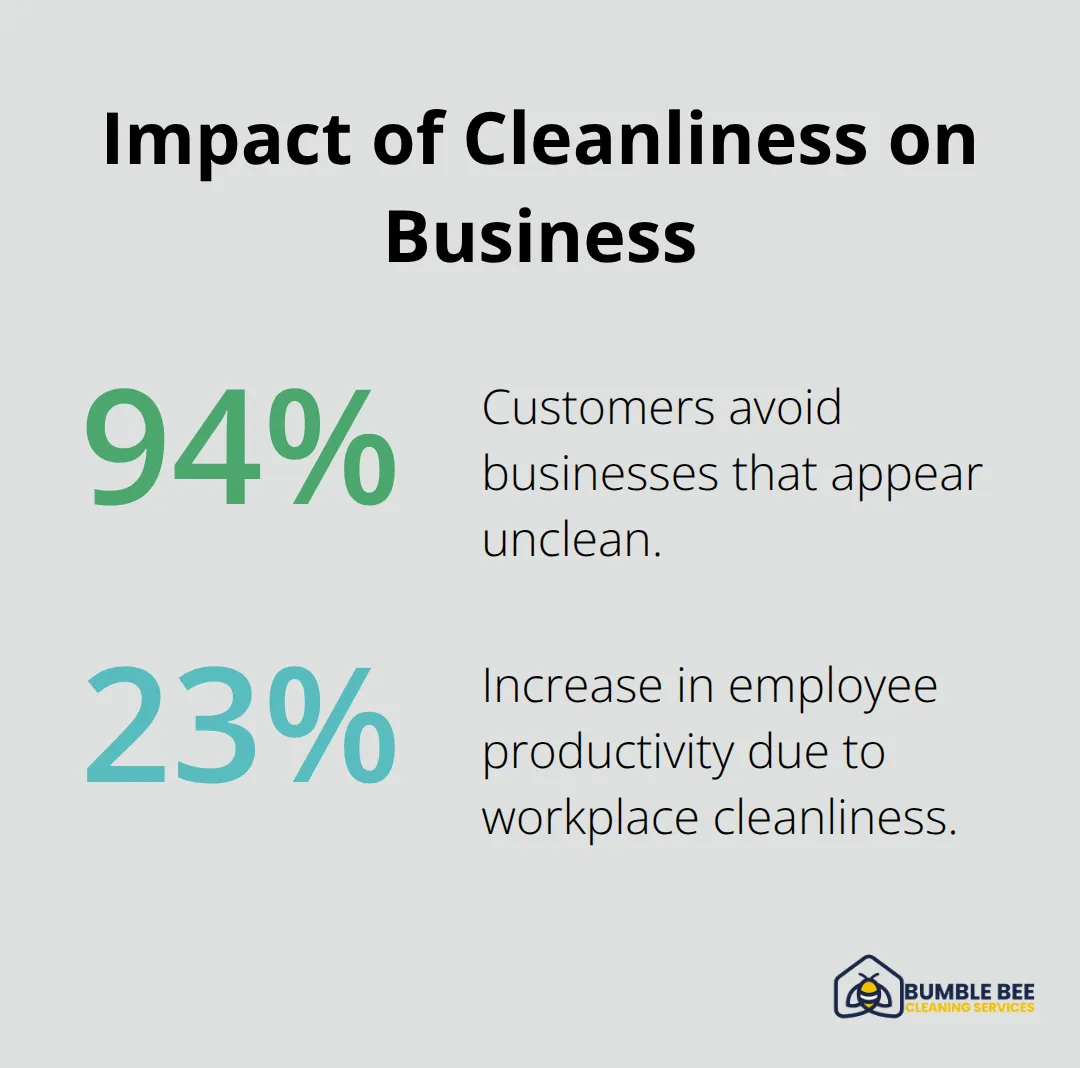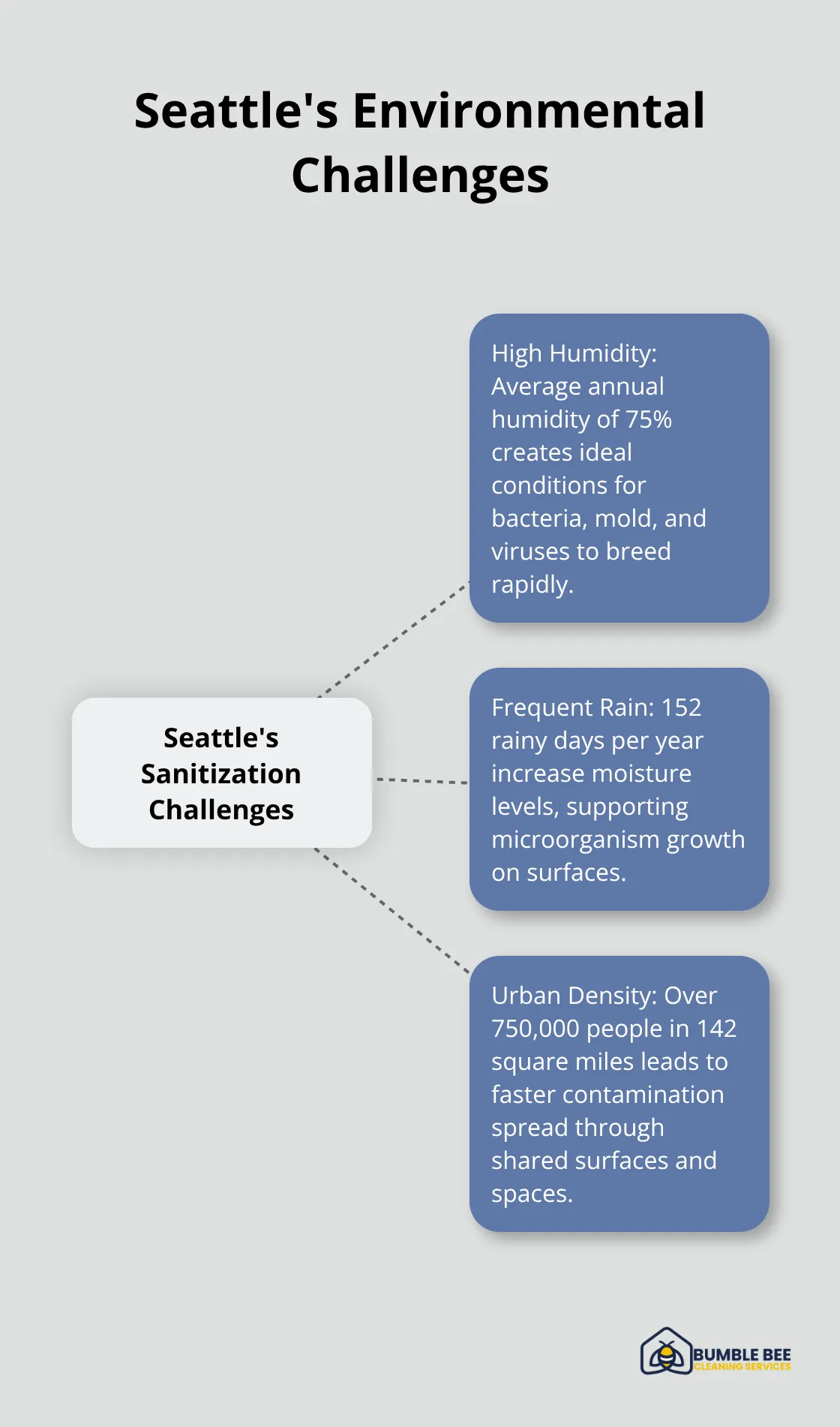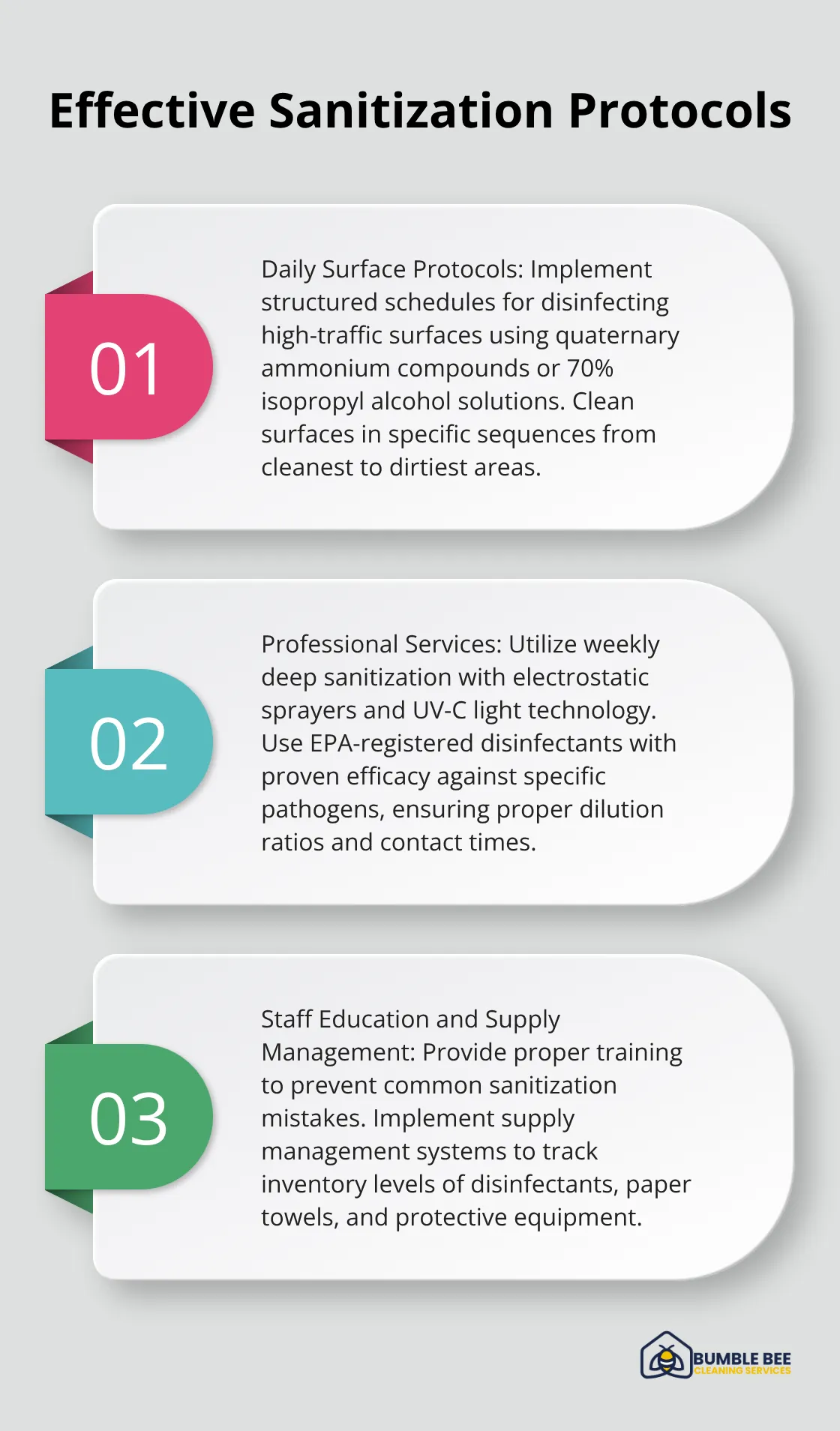Seattle businesses face unique health challenges that make regular sanitization more important than ever. The city’s high humidity and dense urban environment create perfect conditions for bacteria and viruses to thrive.
Commercial sanitization programs protect your employees, customers, and bottom line. We at Bumble Bee Cleaning Services see firsthand how proper sanitization reduces sick days and prevents costly outbreaks in workplaces across the Pacific Northwest.
How Sanitization Impacts Your Business Health
Regular sanitization delivers measurable health benefits that directly impact your Seattle business operations. The International Sanitary Supply Association found that 94% of customers avoid businesses that appear unclean, while workplace cleanliness can boost employee productivity with a 23% increase according to sustainable office design research. Seattle’s 152 rainy days per year create moisture conditions that support bacterial growth, which makes consistent sanitization programs essential for healthy indoor environments.

Employee Wellness Drives Business Performance
Professional sanitization reduces employee sick days when it eliminates common workplace pathogens like rhinovirus and influenza. Research shows that indoor air quality concerns exist in urban environments, which creates health risks that proper sanitization addresses. Companies that implement comprehensive programs report lower healthcare costs and reduced absenteeism rates. Daily disinfection of high-touch surfaces (like door handles, keyboards, and break room equipment) prevents cross-contamination between staff members.
Customer Safety Builds Business Reputation
Visible cleanliness standards directly influence customer confidence and repeat business. Professional sanitization creates safer environments when it removes harmful bacteria, viruses, and fungi that thrive in Seattle’s humid climate. Regular deep processes with HEPA filtration systems remove 99.97% of airborne pollutants, which protects both customers and staff from respiratory issues. Businesses that maintain high sanitization standards demonstrate commitment to public health, particularly important in post-COVID operations where customer expectations for cleanliness have permanently elevated.
Outbreak Prevention Protects Operations
Systematic sanitization programs prevent disease outbreaks that can shut down business operations. Professional services use EPA-approved disinfectants and proven protocols to eliminate pathogens before they spread throughout your facility. Seattle’s dense urban environment increases contamination risks from foot traffic and shared surfaces (which makes proactive sanitization more valuable than reactive measures). These health challenges become even more complex when you consider Seattle’s specific environmental factors that create unique sanitization needs.
Why Seattle’s Climate Creates Sanitization Problems
Seattle’s environmental conditions create specific sanitization challenges that demand targeted solutions from local businesses. The city’s average annual humidity of 75% combined with 152 rainy days creates ideal conditions where bacteria, mold, and viruses breed rapidly. The Pacific Northwest’s dense urban population of over 750,000 people in just 142 square miles means contamination spreads faster through shared surfaces, public transportation, and high-traffic commercial spaces.

Moisture Levels Support Harmful Microorganisms
Seattle’s persistent humidity levels between 70-80% during winter months allow harmful microorganisms to multiply rapidly on surfaces that appear clean. Professional sanitization services must use specialized equipment like dehumidifiers and antimicrobial treatments to break the cycle of bacterial reproduction that thrives in Seattle’s wet climate. Standard disinfectants lose effectiveness in high-humidity environments (which requires EPA-approved solutions specifically formulated for Pacific Northwest conditions).
Urban Density Accelerates Contamination Spread
Seattle’s compact urban layout with shared elevators, crowded sidewalks, and limited parking creates multiple contamination touchpoints that rural businesses never face. Sound Transit ridership data shows over 400,000 daily passengers use public transportation daily, with each commuter carrying potential pathogens into office buildings and retail spaces throughout the city. The Washington State Department of Health reports that Seattle businesses experience seasonal flu outbreaks 40% more frequently than suburban locations due to population density and shared air circulation systems in older buildings.
Seasonal Weather Patterns Complicate Sanitization
Seattle’s distinct seasonal patterns create different sanitization challenges throughout the year. Spring brings pollen that accumulates on surfaces and triggers allergic reactions, while summer heat combined with humidity creates perfect conditions for bacterial growth. Fall introduces leaf debris and increased moisture from rain (making entrance areas particularly vulnerable to contamination). Winter salt and de-icing chemicals tracked indoors require specialized cleaning protocols to prevent surface damage while maintaining sanitization standards. These seasonal variations require businesses to adapt their sanitization programs to address specific environmental challenges that change throughout the year.
What Sanitization Protocols Work Best
Effective sanitization programs require systematic approaches that address Seattle’s specific environmental challenges through targeted daily protocols and professional oversight. Washington State Department of Labor & Industries sets foundational quality standards for programs promoting health, safety, and well-being, while the CDC recommends EPA-approved disinfectants with minimum contact times of 30 seconds for virus elimination. Seattle businesses must implement structured schedules that address door handles, elevator buttons, restroom fixtures, and shared equipment with hospital-grade disinfectants that remain effective in the city’s 75% average humidity levels.

Daily Surface Protocols That Actually Work
High-traffic surfaces require disinfection with quaternary ammonium compounds or 70% isopropyl alcohol solutions that work effectively in humid conditions. Businesses that follow structured protocols see enhanced transparency and reduced safety incidents when staff clean surfaces in specific sequences from cleanest to dirtiest areas. Reception desks, conference room tables, and break room appliances need attention every four hours during peak usage periods (while restroom surfaces require hourly disinfection in facilities with over 50 employees). Digital thermometers and hand sanitizer dispensers should be refilled twice daily and cleaned with alcohol wipes to prevent cross-contamination between users.
Professional Services Deliver Measurable Results
Weekly deep sanitization uses electrostatic sprayers and UV-C light technology to remove pathogens that daily processes miss, particularly in HVAC systems and carpet fibers where humidity allows bacterial growth. Professional services use EPA-registered disinfectants with proven efficacy against specific pathogens, while staff programs teach proper dilution ratios and contact times that many businesses get wrong when they handle sanitization internally. The King County Health Department requires monthly documentation of sanitization activities for food service businesses (which makes professional services valuable for compliance management and liability protection).
Staff Education and Supply Management
Proper staff education prevents common sanitization mistakes that reduce disinfectant effectiveness in Seattle’s challenging climate conditions. Employees must understand that different surfaces require different contact times, with porous materials like fabric chairs needing longer exposure to disinfectants than hard surfaces like metal door handles. Supply management systems track inventory levels of disinfectants, paper towels, and protective equipment to prevent shortages during peak flu seasons when demand increases according to Washington State health data.
Final Thoughts
Regular sanitization programs deliver substantial financial returns that extend far beyond immediate health benefits. Seattle businesses that invest in professional sanitization services typically see 25% fewer employee sick days and reduced healthcare premiums within the first year of implementation. The International Facility Management Association reports that outsourced services cut operational costs while they maintain higher standards than internal programs.
Commercial sanitization creates competitive advantages that directly impact customer retention and business growth. Companies with visible cleanliness standards attract more customers and command premium prices in Seattle’s competitive market. Professional services eliminate the guesswork from sanitization protocols while they provide documentation that satisfies King County health regulations and insurance requirements.
We at Bumble Bee Cleaning Services understand that Seattle businesses need reliable partners who can navigate the city’s unique environmental challenges (from persistent humidity to dense urban contamination). Our team provides sanitization programs that meet industry standards while they protect your investment in employee health and customer safety. Professional sanitization services provide measurable value through reduced liability, improved productivity, and enhanced reputation that makes the investment worthwhile for any serious business operation.
